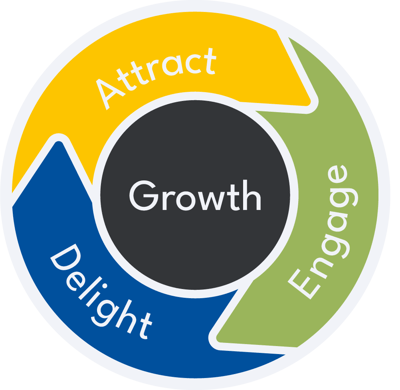Both Google and your audience are hungry. Serving up great content isn’t enough - you need to make it mouth-wateringly irresistible.
How do you do that? By providing content that your audience is hungry for. This is the core tenant of inbound marketing. But if you want your audience to find that content, then you need to EEAT.
EEAT (Expertise, Experience, Authoritativeness and Trustworthiness) is the secret sauce that transforms a bland piece of content into something craveable. Here's how it works, and what you need to know.
Key Takeaways:
- EEAT isn't a ranking factor, but Google does prioritize EEAT-friendly content.
- Show real-world experience and back it up with clear credentials, and build trust beyond your website through community engagement.
- Apply EEAT principles throughout your inbound strategy to boost both search visibility and customer trust.
Skip to a section:
- What is the EEAT Model?
- What Does EEAT Stand For?
- What is Inbound Marketing?
- How EEAT Supports Inbound Marketing
- How to Implement EEAT in Your Inbound Marketing Strategy
What is the EEAT Model?
EEAT is a set of guidelines developed by Google to help website owners understand the methodology behind why and how Google makes ranking decisions. It stands for Experience, Expertise, Authoritativeness and Trustworthiness. I'll break down what each of these factors mean in just a moment.
Is EEAT a Google Ranking Factor?
Yes and no. Google includes EEAT as one of their guidelines for search evaluation. While we don't know exactly how much weight is given to EEAT over other guidelines, we do know that it's one of the guiding principles behind Google's algorithm.
However, Google also says in their official guidelines that EEAT "isn't a specific ranking factor" but they do clarify that: "using a mix of factors that can identify content with good EEAT is useful. For example, our systems give even more weight to content that aligns with strong EEAT for topics that could significantly impact the health, financial stability, or safety of people, or the welfare or well-being of society."
To make it simple: EEAT is not a concrete checklist that Google follows when evaluating your content. However, if you write your content with EEAT guidelines in mind, you're more likely to align with the intent of the algorithm - and therefore more likely to rank higher in search results.
Why Google Prioritizes EEAT
As Google itself says, "Google's automated ranking systems are designed to present helpful, reliable information that's primarily created to benefit people, not to gain search engine rankings, in the top Search results." EEAT is one of the ways Google evaluates content to determine if it meets their standards. To see how, we need to dive into what EEAT stands for.

What Does EEAT Stand For?
1. Experience (E): Does the Content Creator Have First-Hand Experience with the Topic?
Experience refers to how much firsthand experience the author behind a piece of content has with that topic. For physical objects, it can be as simple as "has the person reviewing this product actually used the product?" If the answer is "no," then you probably wouldn't trust their review - so Google doesn't, either.
For more abstract concepts, I like to call this "passing the sniff test." When you're familiar with a subject or niche, you can immediately tell when someone has never engaged with that subject before (something "smells funny" about their comments/input - hence "sniff test"). It might be using the wrong terms, or how they describe things, or it might be a general overall impression.
Why Experience Matters in Content
Again, let's go back to Google's goal of presenting "helpful, reliable information that's primarily created to benefit people." Content that isn't written with Experience flies in the face of that goal. Not everything in Google's soup of ranking factors is complicated - Experience is one of those simple concepts that describes exactly what it sounds like. Have you actually used this thing you're talking about?
Experience vs. Expertise
It's important to note that Experience does not necessarily mean "is a subject matter expert in this topic." A software engineer and a hair stylist might both leave a review for a SaaS tool online that each has used for their respective business. Even though the engineer likely has more Expertise in how that SaaS tool works, both reviews equally meet the Experience metric, as they've both used the tool.
2. Expertise (E):
Expertise refers to depth of subject matter knowledge. I love the example Google gives on how to define expertise, so I'm going to borrow it:
"Different topics require different levels and types of expertise to be trustworthy. For example, which would you trust: home electrical rewiring advice from a skilled electrician or from an antique homes enthusiast who has no knowledge of electrical wiring?"
For a lot of our B2B clients, Expertise is one of the essential pillars of EEAT, as their organizations often address needs that are niche, complex and highly specific.
How Google Evaluates Subject Matter Expertise
Use these questions from Google when evaluating your content to determine if it demonstrates Expertise:
- Does the content present information in a way that makes you want to trust it, such as clear sourcing, evidence of the expertise involved, background about the author or the site that publishes it, such as through links to an author page or a site's About page?
- If someone researched the site producing the content, would they come away with an impression that it is well-trusted or widely-recognized as an authority on its topic?
- Is this content written or reviewed by an expert or enthusiast who demonstrably knows the topic well?
- Does the content have any easily-verified factual errors?
How to Demonstrate Expertise in Your Niche When Someone Else is Writing the Content
Expertise can be tricky for large organizations, as the person who is actually writing content is often a member of an internal marketing team or a partner agency. This means that it's important to ensure that your content is reviewed by someone who has that experience. This could be the business owner or someone else in the C-Suite, or it could be as simple as another employee reviewing who has significant knowledge.
3. Authoritativeness (A):
Authoritativeness is a reputation metric. It looks at how much the content creator and/or website is considered a trusted source for a given topic. For example - Google will give more weight to the official government page on getting a passport over a blog post from a frequent traveler.
The Trouble with Authority
Because Authoritativeness is defined by an organization's reputation, you may not have as much control as with other metrics. Going back to the passport example - if you're a local tourism board, you are never going to be able to compete with the government website on the subject of securing passports. However, you might be able to gain Authoritativeness for content related to "things to do" in a given city.
How to Build Authority Online
To build your Authoritativeness, you'll need to consider other avenues beyond content creation. While creating Authoritative content for Google is certainly helpful, it's not the most important step. You should also:
- Build up your professional network. Not just one-to-one connections, but the network of your business as well. You can build authority by being a member of professional organizations and having certifications in your niche.
- Cultivate reviews and user-generated content. Content about your organization that doesn't come from your organization is weighted heavily in Google's analysis of your reputation and Authoritativeness. Google wants to see what your customers, employees and vendors are saying about you.
- Focus on offline reputation-building as well. This includes things like hosting events, contributing to the community and other efforts that help establish your name in your niche. This offline activity bleeds into your online reputation, as others will search for your organization online and potentially post about efforts.
4. Trustworthiness (T):
Trustworthiness can be both the simplest and most complex factor in EEAT. The definition from Google is simple: "the extent to which the page is accurate, honest, safe, and reliable." But identifying what specific phrases, words and content promote Trustworthiness can be challenging. This is why Trustworthiness is considered the culmination of every other element in EEAT.
How EEAT Builds Trust
To build Trustworthiness, you need to build up Experience, Expertise and Authoritativeness. The guidelines for those three factors create trust with your audience. When evaluating trust, Google looks for:
- What the website and content creators say about themselves.
- What others say about the website or content creators.
- What is visible on the page, including the main content and sections such as reviews or comments.
All of these elements are run through the EEAT framework to determine Trustworthiness.
Conflicts of Interest and Other Anti-Trustworthiness Factors
It's important to note that there are a few scenarios where you may meet EEAT on paper, but that might violate trust. One example is a review of a product posted by the manufacturer of the product. While, yes - it does demonstrate Experience, it's also not trustworthy. There's a heavy bias that flies in the face of the purpose of reviews.
Likewise, it's important to consider reputation through customer service information for online stores, peer-reviewed publications for academic authors and scam watcher websites. Infamy around an organization can also impact their Trustworthiness score.
What is Inbound Marketing?
Inbound marketing is a modern approach to digital marketing. Instead of casting a wide net and trying to chase down customers, inbound marketing focuses on attracting your ideal customers who are most likely to convert into sales.
Instead of interrupting your audience with annoying junk they don't want, inbound marketing helps your customers during their buying journey by solving the problems they already have. This aligns more with modern customers' expectations around the purchasing process.
The Core Principles of Inbound Marketing
The best way to understand how inbound marketing works is by looking at the core principles of inbound marketing:
- Inbound marketing is customer-oriented and customer-driven. Everything you do is based on your audience taking the first action.
- There is no one-size-fits-all marketing strategy. Content needs to be personalized to your ideal audience(s). This means understanding the decisions behind why they make a purchasing decision, where they spend their time online and what types of content are most likely to influence their decision.
- Empathy and solution-selling are vital. Even for B2B decisions, empathy plays a huge role in how decisions are made. You're not selling what you do. You're selling what you do as the answer to your prospects' needs.
- Inbound marketing recognizes that the sale doesn't end with the sale. Your current customers are a massive potential revenue stream. It's not just about impressing them so they make more purchases in the future - although that's important, too. It's about the word-of-mouth and reputation that your customers will spread.
Inbound Marketing vs. Digital Outbound Marketing
It's important to know how inbound marketing differs from traditional digital outbound marketing. The tactics you use for both are the same - content marketing, SEO, online advertising, social media - but what differs is the how and why.
Digital outbound is all about the chase. It's casting a large net and seeing what bites. Inbound is all about attraction. It's focusing on that smaller pool full of bigger fish.
The Phases of Inbound Marketing
The inbound methodology is based around the concept of a flywheel, which is broken down into phases that overlap and feed each other. The flywheel serves as the framework of your inbound campaigns and helps you understand what specific pieces of content and what specific offers will resonate with a buyer based on where they currently sit in the flywheel:

- Attract: Earn your audience's attention, don’t force it. Attract visitors with useful content and eliminate barriers as they try to learn about your company.
- Engage: Open relationships, don’t just close deals. Enable buyers to engage with you on their preferred timeline and channels. Tie sales incentives to customer success not just close rate.
- Delight: Tie your success to your customers. Shift resources to be more effectively distributed throughout the entire customer experience.
Related Content: How to Get Started with Inbound Marketing
How EEAT Supports Inbound Marketing
If inbound marketing is all about getting people to find you instead of you chasing them, and EEAT is all about getting found more often on Google - then it makes sense to pair inbound and EEAT.
The EEAT philosophy aligns with the inbound philosophy: the end goal is to get the right content to the right person at the right time. You can follow the EEAT guidelines when creating content for your inbound marketing strategies to help your ideal audience find you.
Why Trust is Essential for Attracting Leads
The inbound methodology is all about a fair exchange. Your ideal customer will exchange their contact information in order to receive something valuable. That exchange can only be possible with a foundation of trust.
Without trust, why should a lead give you their contact information? Following the EEAT guidelines helps establish this trust: trust that you are who you say you are, trust that you know what you're talking about and trust that you're a responsible organization.
On a practical level, sites that fail the trustworthiness guideline will likely drive users away from taking action. Would you submit a form with your name, email and phone number on a website that isn't secure? Hopefully not.

go EEAT Helps You Rank and Convert
Let's return back to the three stages of inbound marketing. We can see how EEAT also impacts each step of this process:
Attract Stage: Is This Information Answering My Questions?
During the attract stage of the inbound flywheel, users are looking for content that is actually speaking to the questions they're asking. They don't want a bait-and-switch where the title of a blog doesn't line up with the content inside said blog. The experience guideline most directly relates to this consideration. A user within your niche will be able to quickly tell if you're speaking from a place of experience, or just stuffing a page with the right phrases to see what sticks.
Engage Stage: Is This Information Accurate?
When leads move into the engage stage, they're looking for deeper content that will provide value. This also calls on experience, but it dips into expertise as well. Leads engaging with content want to know that the information is accurate.
Decision Stage: Can I Trust This Source?
As leads move into their decision stage, they're taking a closer look at the who behind the information. This is where the authoritativeness and trustworthiness guidelines come into play. Can a lead put trust in navigating your website safely? Is your organization reputable? Are you known in your niche? These are all considerations that your leads will be weighing strongly when deciding if they want to take the next step toward becoming a customer.
How to Implement EEAT in Your Inbound Marketing Strategy
1. Use EEAT Guidelines in Your Content Strategy
Content is the heart and soul of inbound marketing. This includes the assets themselves, blog posts, website pages, online ads, landing pages, emails, social media posts - the list goes on and on. Whatever piece of content you work on, you should ensure that EEAT guidelines are the foundation of your content strategy.
Practically, this will mostly apply to the research and writing of your content. This includes:
- Using reputable sources that are cited. You can see examples of this throughout this article, where I link out to Google's guidelines.
- Creating case studies or other content that demonstrates real-world experience.
- Showing proof of experience with original research, personal experience and images or videos.
- Clearly defining when a statement is an opinion or personal experience (Note: this doesn't have to be complicated. When it's coming from you, write it in first person. When it's not, write it in third and cite your sources).
- Providing credentials whenever possible. If a user has never heard of you before, why should they listen to anything you say on this topic?
- Writing in-depth, well-researched content that's focused on providing value.
- Updating old content to maintain accuracy. This also includes making publication dates visible, so your users can see when a piece of content was last updated.
- Have subject matter experts create your content or, at minimum, review it.
- Solicit the opinions of others in your niche. This includes guest posts, interviews or reviews.
These are all guiding principles that should be a core part of your content strategy for your inbound marketing.
Prioritize Topics Over Keywords
Another way to center EEAT principles is to shift your focus away from hitting exact keywords and toward writing around topics. Google no longer ranks sites by scanning a page to see how often a specific phrase is mentioned. Instead, they consider EEAT and other factors that look to see how well does this content answer the question(s) behind the search query?
This means that Google's algorithm doesn't prioritize exact phrase matches. It's looking deeper into the content to tease out meaning and context. To rank on Google, you need to approach your content creation from the same understanding.
Related Content: Why You Should Use Topics, Not Keywords
2. Leverage Backlinks and Citations for Authority
Authoritativeness and trustworthiness both rely on factors outside of your website. What are others saying about your organization? What websites are linking back to your website? And under what context?
To ensure your inbound marketing campaigns meet these guidelines, you need to create a backlinking strategy. Honestly, the specifics of how to build an effective backlinking strategy could be its own blog post (and probably will). For now, I'll send you to Semrush's excellent guide to building backlinks, and give you some basics to get started:
- List your business on reputable directories. Google Business Profile, Yelp and industry-specific directories are all important for building your backlink authority. Just be sure to vet directories before creating a listing - there are fake directories that will actually harm your SEO. Use this guide from Ahrefs to spot link farms.
- Monitor your backlinks and disavow toxic sites. Using tools like Ahrefs and Semrush, you can see all of your existing backlinks and where they live. You'll want to disavow sketchy and spammy websites to avoid having too many toxic backlinks to your site.
- Make your content easy to cite. You want other websites to cite you. Some of that goes back to your authority score, but it also includes the formatting of your content as well. Make things scannable, with important text bolded or italicized. Your blogs should have a clear author and publication date, so that they can be more easily cited.
- Create useful content. Aka - follow EEAT guidelines in your content strategy (see last section). The more helpful your content is, the better your chances are that other websites will cite your information.
3. Use AI Without Hurting Your EEAT Score
If you've experimented with AI in your inbound marketing efforts, you may be wondering how you can use generative AI and still meet Google's EEAT guidelines. When using AI to assist in your inbound content creation, it's important to follow these standards:
- Never publish AI-generated content without human review.
- Treat AI as an assistant, not as a replacement for human marketers.
- Fact-check everything. When using data from AI, ask it to cite its sources and independently fact-check these sources.
- Focus on quality, not quantity. As the EEAT guidelines show, producing higher-quality content less frequently is much more appealing to Google than frequently pumping out low-effort content.
Related Content: 3 Pitfalls to Avoid with AI Content in Marketing

4. Track the Signs Your EEAT is Improving
If you're like me, after learning all about EEAT you want something that will measure how your site stacks up and give you a score you can track and improve. The bad news is that doesn't really exist. EEAT are guidelines, not exact measurements - and Google is also cagey about revealing the specifics of how their algorithm works.
However, that doesn't mean that you can't still monitor your inbound marketing efforts to see how well you're meeting your EEAT goals. Most tools that track SEO will also track the same EEAT signals that Google does. Both Ahrefs and Semrush have tools that will show you how well your website is ranking. If you have an SEO program with BizzyWeb, we also track these for you and report on them each month.
Following EEAT when developing your inbound campaigns is important for creating content that not only ranks on Google, but also resonates with your audiences. As you refine your approach, remember that the ultimate goal is to provide value and authenticity. By doing so, you'll not only enhance your online presence, but also drive meaningful engagement and conversions.
Inbound Marketing with BizzyWebBizzyWeb is a Minneapolis-based digital and inbound marketing agency that creates powerful inbound campaigns for our clients and provides education so our clients can become powerful inbound marketers themselves. As a HubSpot Partner Agency, we rely on the power of HubSpot’s suite of inbound-ready tools to execute these tactics.
Learn more about our inbound marketing services here.
BizzyWeb is a Minneapolis-based digital marketing and web design agency that helps companies get the high-quality leads they need to grow and thrive. Our tactics include inbound marketing, SEO, advertising, web design, content creation and sales automation. We are an accredited HubSpot Diamond Partner and we offer full-service HubSpot onboarding, enablement and strategy for new and current users.





